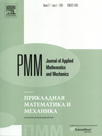 | | Journal of Applied
Mathematics and Mechanics
Russian Academy of Sciences | | Founded
in January 1936
(Translated from 1958)
Issued 6 times a year
ISSN 0021-8928
(print version) |
Archive of Issues
| Total articles in the database: | | 10482 |
| In Russian (ΟΜΜ): | | 9683
|
| In English (J. Appl. Math. Mech.): | | 799 |
|
| << Previous article | Volume 79, Issue 1 / 2015 | Next article >> |
| A.V. Zykov, V.P. Legostayev, A.V. Subbotin, A.V. Sumarokov, and S.N. Timakov, "The dynamics of a rotating solar sail when it is deployed," J. Appl. Math. Mech. 79 (1), 35-43 (2015) |
| Year |
2015 |
Volume |
79 |
Issue |
1 |
Pages |
35-43 |
| DOI |
10.1016/j.jappmathmech.2015.04.016 |
| Title |
The dynamics of a rotating solar sail when it is deployed |
| Author(s) |
A.V. Zykov (Moscow, Russia)
V.P. Legostayev (Moscow, Russia)
A.V. Subbotin (Moscow, Russia, awsubbotin@mail.ru)
A.V. Sumarokov (Moscow, Russia)
S.N. Timakov (Moscow, Russia) |
| Abstract |
A model of the release of a solar sail array, in which the sail, deployed from the packed state, is represented in the form of four released tethers, is considered. At the initial stage of the unfolding of the solar sail, taking into account the central symmetry of the constructional arrangement of the spools with the tethers, the release of one of the tethers is modelled on the assumption that all the remaining tethers are released in synchronism and the release control system ensures dynamic symmetry of the process. A differential equation of the small transverse oscillations in the plane of rotation of a point mass on a weightless tether during the deployment from the rotating central unit, is presented. An analytical solution of the linearized equation of the deployment of a point mass is obtained, expressed in terms of the Bessel functions for uniform deployment and in terms of the hypergeometric functions for a uniformly decelerated deployment. Numerical modelling, carried out for two cases, namely, when the tether is represented in the form of a set of point masses, connected successively by weightless inextensible threads, and in the form of a weightless inextensible thread with a heavy load at the free end, confirms the analytical results obtained. |
| Received |
13 August 2013 |
| Link to Fulltext |
|
| << Previous article | Volume 79, Issue 1 / 2015 | Next article >> |
|
 If you find a misprint on a webpage, please help us correct it promptly - just highlight and press Ctrl+Enter If you find a misprint on a webpage, please help us correct it promptly - just highlight and press Ctrl+Enter
|
|

 Russian
Russian  English
English